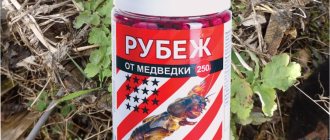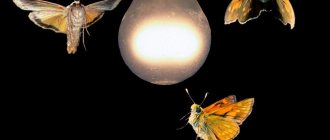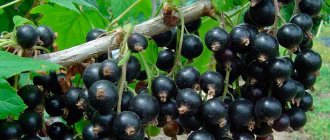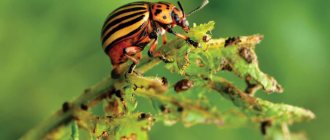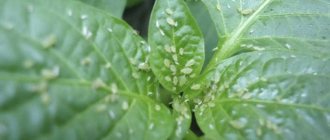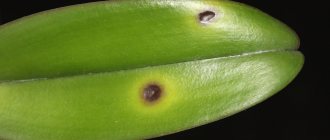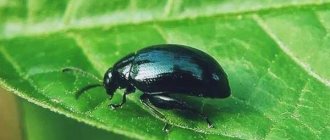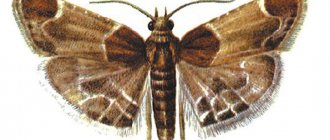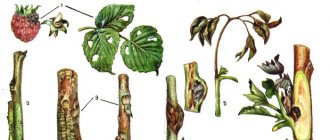It’s not just you who is laying claim to the beautiful cabbage sprawled freely in the garden bed. Various pests are lurking, waiting for the right moment to take over the harvest into which so much time and effort has been invested. The article will help you recognize enemies by sight from the photos provided and will tell you about methods of combating the main types of cabbage aggressors.
Cabbage aphid
One of the most voracious and widespread pests of cabbage. Adults are from 2 to 4 mm, greenish in color, covered with a waxy coating. Their main diet is cabbage juice. As a result of a mass meal, cabbage leaves curl and become discolored.
In mid-summer, winged aphids can be seen migrating to neighboring plants. By autumn, insects lay eggs on stalks and weeds. The eggs overwinter, and in the spring a new colony hatches - the cycle repeats.
Experienced gardeners recommend planting cabbage with the right neighbor, which will repel parasites. Dill or tomato are suitable for this protective role. Many summer residents prefer spraying with a vinegar solution (10 tsp 9% vinegar per 2 liters of water). The procedure is carried out late in the evening. Moisten the leaves generously, starting from the middle of the cabbage and moving towards the periphery.
If aphids are found despite preventive measures, then there is another proven folk method in stock. You will need:
- tar soap (20 g);
- laundry soap (20 g);
- ash (300 g per 10 liters of water).
The ash must be poured into a metal container and poured with boiling water (2.5 l). Mix thoroughly, cover and leave for 20 minutes. After this, the ash solution must be filtered and the volume brought to 10 liters. And then add both types of soap (pre-dissolve it in hot water). Now you can start spraying. Use a powerful jet to try to knock down the colony of parasites from the cabbage leaves. Sprinkle the top of the plant generously with dry ash.
Attention! Wood ash not only repels aphids, but is also an excellent fertilizer for cabbage.
Chemicals against caterpillars
The problem can be quickly and radically solved with the help of pesticides - after 1-2 hours after treatment, most of the caterpillars will die.
However, the use of chemistry has many side effects :
- not only pests will suffer, but also other living organisms, and the local ecosystem may be disrupted;
- adult individuals are less sensitive to poisons than young larvae, so, most likely, you will have to spray the plants with poison again;
- pesticides can be harmful to humans - it is necessary to adhere to safety rules when processing;
- poisons cannot be used less than a month before harvest.
Chemical treatment is carried out in calm weather using personal protective equipment
When deciding to purchase a chemical pest control product, pay attention to the degree of danger it poses to people, pets and bees. A drug whose packaging says hazard class 1 or 2 should not be used in a summer cottage.
Among the most popular (and least dangerous) chemicals are: Fufanon, Kemifos, Antitlin-P and Grinda.
Biological products such as Bitoxibacillin, Fitoverm, Nemabakt, Lepidotsid, Dendrobacillin and Entobacterin-3 will also help to successfully get rid of caterpillars on cabbage. They contain live bacteria that kill pests. The use of drugs of this type allows you to fight cabbage parasites with minimal negative consequences for humans, pets and beneficial insects.
Cruciferous bug
The bug is small in size (5.5 - 8 mm) and variegated in color. The variable pattern consists of dark and colored (yellow, red) spots, dots and stripes. It feeds not only on cabbage, but also on other varieties of cruciferous crops.
Insects hibernate in gardens, nestling comfortably in fallen leaves near trees. In early spring, they settle on weeds, waiting for their favorite cruciferous plants to sprout. And after waiting, they arrange a noble “feast for the whole world.” They pierce the leaves with their proboscis and suck out the plant juice. The puncture sites become discolored, and if the damage is severe, the leaves turn yellow and subsequently die. 15 individuals are enough to destroy a head of cabbage. In addition, not only adult pests, but also larvae participate in the meal.
Attention! In the southern regions of the Russian Federation, the cruciferous bug can produce 2-3 generations per season.
Insecticides will help in controlling cabbage pests:
- Aktara (a highly effective and fast-acting remedy);
- Enzhio (a powerful drug of systemic contact action);
- Match (low toxic substance for beneficial insects and warm-blooded animals).
The following are effective as preventive measures:
- planting seedlings in the early stages;
- timely application of fertilizing in sufficient quantities (cabbage will then be able to withstand the damage caused);
- destruction of weeds in the spring (a breeding ground for bedbugs) and crop residues in the fall (their wintering places).
Preventing insect infestations
Despite the abundance of pest control agents, it is much easier to prevent their invasion than to fight it. Experienced gardeners recommend paying attention to preventive measures, these include:
- digging up the site in the fall;
- removal of plant residues from the garden followed by destruction;
- use of fine mesh to protect against insects;
- planting plants near cabbage beds that repel pests - marigolds, calendula, fennel, dill.
If you discover that someone is eating cabbage seedlings, you should not hesitate. There are quite a few methods of pest control, so dealing with insects will not be difficult. Treatment with chemicals is permissible before the formation of ovaries; at other stages of the growing season, preference should be given to biological preparations or folk remedies.
Cruciferous flea beetle
This is exactly the case when size doesn't matter. With a body length of 2-3 mm, the flea beetle is a very serious pest. At the end of April, insects leave their wintering grounds and gain strength on weeds in anticipation of their favorite delicacy - cruciferous plants (cabbage, radishes, rutabaga).
Young cabbage leaves are especially vulnerable. Tiny bugs are capable of riddling seedlings in one day. Small aggressors bite into a delicate plant, leaving behind many depressions or through holes. And the beetle larvae eat the roots at this time.
Flea beetles are especially active in hot and dry weather. It’s not hard to guess that after such “treatment” you shouldn’t even dream of a good cabbage harvest.
Therefore, there is no need to wait for pests to appear. Focus all your efforts on preventing the invasion.
- Choose early varieties of cabbage (planting in early April) or late varieties (in July). Plants have time to grow and harden sufficiently to lose their food attractiveness to insects.
- Weed control. A simple measure that will deprive fleas of their habitat.
- Abundant watering. Fleas do not tolerate dampness well.
- Phytoncidal plants (dill, garlic or coriander). The specificity of their aroma is not to the liking of cabbage pests.
- Shelter of young shoots. Agrospan or a similar covering material will help protect against flea beetles until the crop gets stronger.
Effective methods of control are:
- Dusting cabbage leaves (wood ash, tobacco dust, ground pepper).
- Spraying with homemade infusions (tops of tomatoes, potatoes, garlic, wormwood and other popular folk remedies).
- Chemicals (Decis, BI-58, Imidalit, Iskra DE).
Attention! When using chemical insecticides, it is important to adhere to the specified frequency of application. Otherwise, the effectiveness of the measures taken will be significantly reduced.
Main pests and treatments
An experienced gardener is able to determine the type of pest that has appeared in the beds by the appearance of cabbage, assess the degree of damage, and choose the optimal control measures.
Aphid
Small greenish-gray insects feed on cabbage juice; colonies of pests multiply quickly and become more active in hot, dry weather. Affected leaves acquire a pinkish tint and curl. The process of photosynthesis in the plant is disrupted, it loses the ability to absorb nutrients, and heads of cabbage do not set. Aphids are carriers of viral and fungal infections.
What to process. In case of minor damage, cabbage is sprayed with infusions of ash, potato and tomato tops, and tobacco dust. In severe cases, insecticides “Fufanon-Nova”, “Iskra-M”, “Decis Profi”, “Fas” are used, which are diluted according to the instructions.
Thrips
Small insects invisible to the naked eye. They first appear on weeds, then move on to cabbage. The female pest lays eggs, and after a few days the larvae appear. During a season, 7-8 generations of parasitic insects may appear.
Rusty spots appear between the cabbage leaves, and black dots of insect excrement are clearly visible. Pest colonies become more active in hot, dry weather.
What to process. Spraying with infusions of potato or tomato tops, garlic, mustard or hot pepper helps get rid of uninvited guests. In case of mass damage, the drugs “Fufanon-Nova”, “Iskra-M”, “Karate Zeon” are used.
Cruciferous flea beetle
Small bugs measuring 2-3 mm are one of the most harmful pests of cabbage. Black individuals with yellowish stripes on the elytra are distinguished by their jumping ability. The massive appearance of the parasite on young plantings can lead to the death of a significant part of the crop.
Flea beetles eat the above-ground part, gnaw through the thin stem of seedlings, and beetle larvae gnaw at the roots of the crop. The flea does not like moisture, so abundant watering helps improve the situation.
What to process. Effective against the pest are dusting plants with ash and tobacco dust or slaked lime, spraying tobacco infusion, tomato shoots and potato tops, dandelion, and vinegar solution. The following drugs are used: “Aktara”, “Aliot”, “Fufanon-Nova”.
Cabbage scoop
An inconspicuous gray butterfly that is nocturnal. The flight of overwintered insects occurs at the end of May. Butterflies lay eggs on the inside of leaves. After 10-12 days, green or brown caterpillars appear and begin to actively eat the above-ground part of the plant.
They gnaw the stems of young seedlings, and make holes in the leaves of grown vegetables, sometimes leaving only veins of the leaf plate.
How to treat : use insecticides “Iskra-M”, “Inta-Vir”, “Aktellik”, biological products - “Bitoxibacillin”, “Lepidocid”, “Fitoverm”.
Folk remedies: a decoction of hot pepper or wormwood, an infusion of wood ash with tobacco dust. Before spraying, add 40 grams of liquid soap per 10 liters of liquid to the solutions. Timely weeding and loosening of row spacing helps reduce the number of pests.
Cruciferous bug
Red or black insects with a contrasting geometric pattern on the back. The greatest damage is caused by the beetle larva, which pierces the leaf with its proboscis and sucks out the juice. At the site of damage, light spots appear and tissues die, and the cabbage leaf gradually dries out.
What to process. Strong-smelling agents are used against the pest: infusions of valerian, garlic, nightshade, solutions of vinegar and ammonia are used. For severe lesions, pesticides are effective: “Karate Zeon”, “Atom”, “Decis Pro”.
Cabbage and turnip whites
The butterfly has white wings framed by a black border, with two large black spots. 2-3 days after departure, it lays up to 200 bright yellow eggs on the bottom of the cabbage leaf. After 8-10 days, light green or speckled caterpillars appear, which can reach a size of 5 cm.
Leaf-gnawing pests eat the edges of cabbage leaves and make large holes in the leaf blades. In case of large lesions, a skeleton of veins remains from the plant.
What to process. Butterflies are repelled by strong odors - the plants are sprayed with an infusion of garlic, tomatoes, and wormwood. Dusting the leaves with ash helps - the butterfly does not lay eggs on contaminated surfaces.
Insecticides are used against caterpillars: “Decis”, “Karate Zeon”, “Iskra-M”. Early varieties of cabbage are sprayed with biological agents with a short waiting period - “Bitoxibacillin”, “Lepidocide”.
Cabbage fly
There are two known types of pests: spring and summer. The mass emergence of the spring cabbage fly, a gray insect with transparent wings up to 6.5 mm in size, occurs during the flowering of lilacs. This coincides with the timing of planting cabbage seedlings in open ground.
One individual is capable of laying up to 100 eggs. Flies make clutches on the stems of seedlings, the root collar, and in the soil. White larvae appear after 5-8 days and begin to actively gnaw into the stem and root system of the plant. The roots die and the seedlings wither even with sufficient watering.
In mid-late June, the summer variety of the insect emerges. The hatched larvae gnaw winding passages in the stems and leaves of cabbage, which acquire a blue-leaden hue.
What to process. To repel the pest, the soil between the rows is sprinkled with ash and mustard or hot pepper, and watered with a solution of ammonia. If there are a large number of larvae, plants are sprayed with pesticides: “Aktellik”, “Fufanon-Nova”, “Karate-Zeon”, watered at the roots with “Aktara”, “Commander”. Early varieties are treated with biological products - “Fitoverm”, “Lepidotsid”.
Mole cricket and May beetle larva
Pests live underground and gnaw at the roots of young seedlings and adult plants, leading to their death. The mole cricket is a large insect, 3-5 cm in size, brown-brown in color with a hard shell. The larvae of the May beetle are thick, white, 3-3.5 cm in size.
Parasites enter beds from fresh manure or compost heaps and are activated when the soil becomes waterlogged. The presence of pests can be suspected if there is a sudden sudden death of plants for no reason. The mole cricket leaves small holes and earthen paths near the cabbage bushes.
What to process. To repel pests, the beds are spilled with infusion of garlic, ammonia or mustard. The following drugs help destroy parasitic insects: “Aktara”, “Bazudin”, “Medvetox”, “Zemlin”. The holes are watered with pesticides, and granular forms are placed under the plants.
Slugs
Voracious mollusks cause a lot of trouble for gardeners in rainy weather. On sunny days, slugs hide in the lower leaves of the cabbage. Pests actively eat leaves; their saliva contains an enzyme that leads to darkening of leaf plates and the development of rot. Shellfish serve as carriers of viral and fungal pathogens.
What to process. Plants affected by slugs are sprayed with a vinegar solution, infusion of mustard or hot pepper. They set traps - sugar syrup or beer is poured into small containers, then the drowned pests are collected. Pesticides are used: “Metaldehyde”, “Slug eater”. Granules of the preparations are laid out under bushes and between rows.
Slugs
All types of cabbage are the signature dish for the soft-bodied pest. Externally, slugs are similar to a snail. A distinctive feature is the absence of a shell. Therefore, their bodies are covered with a thick layer of mucus, which prevents them from drying out.
The favorite period of hunting in the beds is from dusk to morning. The rest of the time, slugs hide in secluded places. The exception is cool and damp days. You can find out that the harvest hunting season is open by the silver marks on the cabbage and by the numerous holes in its leaves. Now all that remains is to be patient; the battle with slugs will be labor-intensive, troublesome and not without losses on the crop.
Experienced farmers resort to a variety of measures.
- Spraying in the evening with vinegar (a glass of 9% vinegar per bucket of water) or mustard solution (150 g of powder per bucket of water).
- Sprinkling ash, crushed shells or sand around the heads of cabbage.
- Treatment with onion peel infusion. It is poured with boiling water and kept covered for 3-4 hours. Then it is slightly diluted with water to reduce the concentration and the affected cabbage is treated.
- Ammonia with tar soap. For 5 liters of water take 1 tbsp. l. ammonia and soap. Treat vegetables with a solution from a watering can once a week (after regular watering).
- Ulitsid. A highly effective and safe product for people and animals based on iron phosphate.
Some gardeners go hand-to-hand against voracious gastropods:
- Lay the boards on damp soil between the rows. After the meal, the slugs crawl under them for an afternoon nap. That’s when the angry owner of the crop takes the shellfish “lukewarm.”
- They dig containers with treats (beer, kvass, fermented compote or syrup) around the cabbage, and in the morning they collect the tipsy overnight guests.
One of the exotic and desperate measures is to attract natural enemies of slugs (toads, frogs, hedgehogs) to the site.
Effective methods for controlling cabbage pests
If you find insects in a garden bed, you need to act quickly, because they multiply intensively and spread to healthy bushes. In the initial stages of damage, it is easier to solve the problem, and you can use the most harmless means of control that our grandmothers used. If pests are discovered late, and their colonies are steadily increasing, threatening to destroy the crop, chemicals will come to the rescue.
Folk remedies for cabbage pests
When you discover that someone is nibbling on cabbage in your garden bed, it is important to find out what type of insect is involved. Depending on the result, the means that will be most effective are selected.
Cruciferous flea beetles are repelled by wood ash. A soap-ash solution is prepared on its basis. A filled liter jar of ash and half a piece of laundry soap are dissolved in 10 liters of water. The resulting mixture is sprayed onto cabbage.
Important! Cabbage aphids, bedbug and butterfly larvae are usually found on the underside of leaf blades. To be sure to get rid of them, it is best to use a sponge dipped in a soap-ash solution. With its help, it is easier to remove masonry and the pests themselves.
Other means are used to treat bushes against aphids, thrips and whiteflies:
- Vinegar solution. To prepare it, pour a glass of vinegar or 2 tablespoons of essence into a bucket of water (10 l).
- Valerian. The composition for spraying is prepared both from the rhizomes of the plant and from a pharmaceutical tincture. A bottle of valerian is diluted in 10 liters of water.
- Garlic infusion also copes well with the task. You will have to chop 10 heads of vegetables and fill the raw material with 3 liters of water. After infusing for 24 hours, the concentrate is filtered and diluted 1:1 with plain water.
- A decoction of tansy will repel cruciferous flea beetles and bedbugs. You will need 500 g of raw materials (greens), which is poured with 2 liters of boiling water and simmered over low heat for 40 minutes. The product is infused for 2 days and diluted 1:1 with water. Cabbage plantings are sprayed with the decoction once a week.
In addition to liquid formulations, bulk products are also used to dust cabbage - ash in its pure form or in combination with tobacco dust and red pepper. The soil under the plants can also be treated. Baking soda will protect you from caterpillars. It is mixed in equal parts with wheat flour and sprinkled with cabbage leaves. After eating this seasoning, the butterfly larvae will die.
Attention! The smell of wormwood helps protect cabbage plantings from insects. Weed branches are laid out between the rows and directly under the seedlings.
To combat slugs, gardeners use traps filled with beer or compote. They are located in shady, damp places where shellfish usually find refuge on hot days. Baits attract ill-wishers. All that remains is to empty the traps.
An easier way to protect yourself from slugs is an obstacle course. A layer of sawdust, shell rock or broken brick is scattered around the cabbage beds. The mollusks will not be able to get over such a barrier without getting injured, which means the cabbage will survive.
Saline solution
Use salt to fight cabbage fly larvae. To do this, dissolve 150–200 g of salt in 10 liters of water and spill the soil under the plants. The larvae die after this procedure. Some gardeners put paper skirts on the stems of their seedlings. They prevent fly larvae from penetrating into the soil and to the roots.
Chemical pest control
Folk remedies are not always effective against insects. If their colonies increase despite the actions taken, gardeners use chemicals to control pests.
Attention! Chemicals are used only until the head curls, at the initial stage of the growing season.
List of insecticides for treating cabbage:
- Aktara is a systemic insecticide. It is used not only for spraying garden crops, but also for cultivating the soil. Destroys aphids, bedbugs, fleas, caterpillars. To prepare the working solution, the contents of the sachet are diluted in a 10-liter bucket of water.
- Actellik is an insecto-acaricide of contact action. It is used to combat leaf-eating and sap-sucking pests, including mites. The drug has the property of being distributed over the entire surface of the leaf, which increases its effectiveness. Preparation: dissolve 6 ml of product in 5 liters of water.
- Enzhio is a drug created on the basis of pyrethroids and neonicotinoids. It has a powerful effect against various insects and their larvae and a short waiting period of 14 days. The method for preparing a solution for spraying is to dilute the contents of 1 sachet in 10 liters of water.
- Match is an insecticide against caterpillars on cabbage. Principle of action – affects the hormonal processes of pests during molting. The insecticide also affects insect eggs and early instar larvae. The drug is ineffective against older generation caterpillars. Preparation: dilute 4 ml of product in 10 liters of water.
- Proklem is a systemic insecticide that helps fight caterpillars on cabbage and other types of insects that eat its leaves. The composition penetrates deep into the plant tissue. Once the pest enters the digestive tract, it causes paralysis. Method of application: spraying. The solution is prepared as follows: 4 ml of the product is diluted in 10 liters of water.
In addition to the listed drugs, gardeners successfully use Ivermek, Iskra, Karate, Decis and Karbofos. The last resort is used to destroy mole crickets.
Attention! Before using chemicals, you must read the instructions for them. The cultivation of the beds is carried out in dry, windless weather, wearing a mask, protective suit and gloves.
You can also find special insecticides against slugs in stores. They are sold in powder form. The granules are scattered on the surface of the soil under the bushes. After feasting on them, the mollusks die. List of funds:
- Anti-slug;
- Meta;
- Storm.
Biological insecticides
The peculiarity of biological products against pests is that they are created on the basis of living microorganisms - bacteria and fungi. These tools have many advantages:
- low degree of toxicity;
- highly effective against most types of insects;
- safety for humans, animals and pollinating insects;
- short waiting period – up to 5 days.
Bioinsecticides are also used in tank mixtures, which increases the effect of their use against various pests. These preparations can be used to treat cabbage at any stage of the growing season, even shortly before the start of harvesting. List of bioinsecticides:
- Bitoxibacillin;
- Bicol;
- Verticillin;
- Anthonem F;
- Aktofit;
- Aversectin S.
Bioinsecticides
Attention! The effectiveness of biological products decreases at air temperatures below +15 degrees.
Cabbage moth
One of the varieties of butterflies that can cause colossal damage to the cabbage crop. Distributed everywhere. Dimensions do not exceed 1.5 cm, brownish-brown color. It has a peculiar pattern on the wings in the form of a light, unevenly thickened stripe. Very prolific and migrates long distances. All over the world it is considered one of the most important pests of cabbage and other cruciferous crops.
Adults are active at dusk and at night. Eggs are laid on the underside of cabbage leaves. The larvae, having hatched from the eggs, make passages inside the leaf tissues, moving along the main veins. Coming to the surface, dark green caterpillars settle on the plant, putting on a cocoon.
During their development, caterpillars undergo 3-4 molts. All this time they actively feed on cruciferous crops. Subsequently, pupae are formed that are able to tolerate low temperatures. At this stage of transformation, the moth overwinters, and in the spring of next year the cycle starts again.
In the fight against cabbage moths, preventive measures are important: eliminating weeds and residues of cruciferous crops.
Methods for killing moths:
- Installing light traps in garden beds. You will need a regular lamp and a white saucer with oil. The distance between the lampshade and the saucer should be no more than 10-15 cm. The direction of light is vertical. At night, moths flock to the light and fall into the vegetable oil.
- Folk remedies (ash-soap solution, infusion of wormwood or celandine).
- Insecticides. They use herbal (tobacco-based), biological (Entobacterin, Lepidocide, Bactospein) and chemical preparations (Ripcord, Ambush, Talkord).
Attention! Cabbage moths develop resistance to insecticides over time.
Radical secretive proboscis
Radicular secretive proboscis insects are dark gray in color, about 3-4 mm long. In front they have a long and strong black proboscis.
Insect larvae are white, legless, and horseshoe-shaped. Pests overwinter under fallen leaves. With the onset of warm weather, the females crawl out, climb the stems of plants and lay eggs on the surface of the leaves. Females gnaw the stems and make tunnels in them. Over time, they descend to the roots and destroy them. On the surface of the roots you can notice swellings (galls), in which a new generation of gnawing parasites develops.
There is no point in fighting these cabbage pests. In this case, careful digging of the soil in the fall is required, removing fallen leaves and plant debris from the area.
Before planting, cabbage seedlings must undergo quality control for the presence of growths and galls on the surface of the roots. Damaged specimens are discarded as they can cause the development of the disease.
Cabbage whites
A diurnal butterfly with white wings and black spots on them. Cabbage larvae are greenish-yellow in color with short hairs and black dots on the sides. It is the caterpillars that cause significant damage to the crop. In addition, they can harm people. The secretion from the poisonous glands causes skin irritation.
Effective measures to protect against cabbage worms are:
- weed control;
- inspection of cabbage leaves and removal of oviposition;
- manual collection of hatched caterpillars;
- biological products (Lepidocid, Bitoxibacillin);
- chemical insecticides (Calypso, Karate Zeon).
Experienced white grass fighters advise building a simple device on your site. Two sticks are stuck into the ground at both ends of the bed with cruciferous crops. A cord is tied to them. And on it, with a distance of 10-15 cm, ribbons-bows (from a regular white bag) are tied. Under gusts of wind, the bows spin and prevent butterflies from landing on vegetables.
Naked slugs: how to protect cabbage
Slugs overwinter in the egg stage. As soon as the ground thaws, mollusks, barely visible to the eye, begin to feed on plant debris in the ground. After just 2 weeks, they can cause significant damage to seedlings or germinating seeds of grain and legumes. Peak activity in mucus occurs at the age of 1.5–2 months, when they begin to reproduce. Having reached their normal size (3–5 cm), individuals feed on juicy fruits lying on the ground: cucumbers, zucchini, strawberries, etc. Of course, they like cabbage, under the leaves of which they can also hide from the sun.
A naked slug is not protected in any way from aggressive drugs; even dry air is harmful to it
I fight slugs without any chemicals. The pest has a delicate body, unprotected by any coating. He loves dampness, cannot move on dry soil and thorny obstacles, and dies from contact with any burning or caustic agent. Here you have room for imagination. I sprinkle fallen pine needles around the heads of cabbage. But not everyone has the opportunity to get them, so here is a small list of effective remedies against slugs:
- Water your cabbage in the morning, not the evening. Slugs come out of hiding when the heat subsides and quickly move along the wet ground. By watering cabbage at night, you unwittingly attract pests to it.
- Powder the soil in the garden bed with dry mustard. It will effectively burn shellfish both dry and wet.
- Buy special slug baits. You can make them yourself from plastic bottles. This is a cylinder with the top edge curved outward. The slug crawls along such protection, at the very top it finds itself hanging upside down, falls and, if desired, resumes its path or looks for another object to feed on.
- Dig grooves 10–15 cm wide around the cabbage bed. Fill them with material that makes it difficult for slugs to move: sawdust, pine litter, sand, ash, charcoal.
Cabbage scoop
Refers to polyphagous pests. But if there is a choice, he will give preference to cruciferous plants. The armyworm is active in the evening and at night. Moths are colored grayish-brown. The color of the caterpillars varies from gray-green to dark brown (almost black). There are yellow stripes on the sides.
The larvae feed on leaves during the night. At the final stage of their development, cutworm caterpillars are able to eat the entire leaf, leaving only large veins. And then they penetrate deep into the head of cabbage, making winding passages.
Attention! The cutworm is a moisture-loving pest. Most often found in areas with high humidity and moderate temperatures.
You can resist the invasion of the aggressor using the following methods:
- timely removal of weeds;
- loosening the soil to destroy clutches of eggs and larvae;
- early planting of seedlings;
- planting plants that smell unpleasant to insects (marigolds, calendula, garlic, onions) between cabbage heads;
- treatment with herbal infusions (wormwood, tansy, mint);
- dusting with tobacco dust (the material can be a tobacco smoke bomb after it has been used in a greenhouse for its intended purpose);
- covering the cabbage with a net with small holes;
- use of drugs (Sherpa, 5% dust, pyrethrum, Decis, Kinmiks);
- biological products (Lepidocid, Fitoverm, Bitoxibacillin);
- bait traps with molasses or jam, which are hung 1 m from the ground.
Who is the cabbage scoop and why is it dangerous?
The insect is the worst enemy of cabbage, as well as onions, lettuce, peas and beets. The adult butterfly cutworm is not conspicuous due to its unremarkable appearance. The main danger of mature individuals is in the eggs they lay. Over time, they hatch into larvae that quickly spread throughout the plant, damaging the leaves and leaving excrement.
You can fight the cutworm mechanically, collecting eggs by hand, and also using proven chemicals. Its natural enemy, the trichogramma ovi-eater, will also help in the process of exterminating the pest.
Rapeseed sawfly
An orange-yellow insect from the Hymenoptera family. The body length of an adult is 7-8 mm. Pests appear after wintering in the soil in early May. Females lay eggs on the leaves of cabbage and related crops, damaging the tissue in the process. The presence of oviposition is indicated by swellings on the leaf blades. Soon the larvae emerge and begin to actively feed on the host plant.
The larvae (false caterpillars) of the sawfly are gray-green in color with a light stripe along the body. The most favorable conditions for the development of insects are high humidity (70-80%) and temperature 23-26°C.
To protect the crop from the rapeseed sawfly, the following measures are necessary:
- compliance with crop rotation (planting cruciferous crops in the same place for several seasons in a row will increase the risk of pest damage);
- removal of weeds and plant residues after harvesting;
- deep plowing will help destroy insect pupae;
- When sawflies appear, insecticides are used (Kinfos, Fufanon, Fastak).
Petiolate mosquitoes
A microscopic insect, reminiscent of an ordinary mosquito, has transparent wings, a yellow-green body, the length of which is about 2-3 mm.
This pest most often damages cauliflower, savoy and white cabbage. Insect pupae overwinter in the soil. As soon as the heat stabilizes, the females crawl out and lay eggs in the petioles of the leaves. The larvae suck out all the juices from the young petiole leaves.
Plants affected by the petiole mosquito stop growing, their leaves wrinkle and turn yellow.
You can treat cabbage against pests with a decoction of wormwood according to the recipe presented above at intervals of 3 days.
For prevention, it is necessary to keep the area clean and regularly dig up the soil in the autumn.
Cabbage fly
As soon as the soil warms up to +12°C, cabbage flies will begin to fly out. This period coincides with the planting of cabbage seedlings. One female is capable of laying about 150 eggs. The fly selects laying sites in the soil near the root collar of plants.
Attention! The fly does not lay eggs in mulched soil. She is interested in soil with cracks and lumps.
The emerging larvae penetrate the root of the plant and feed here. This destroys soft tissue. And the larva, having made numerous passages, goes deeper into the soil. There she will remain for the winter. Young cabbage with a damaged root system is delayed in development, acquires a bluish-lead tint, and then withers.
Necessary measures:
- preventing the development of cruciferous weeds;
- cleaning of plant residues;
- planting early varieties of cabbage;
- combined plantings with strong-smelling crops (parsley, sage, coriander, celery);
- using infusion of bay leaves;
- dusting with wood ash;
- installing obstacles around plants (cardboard, plastic, other dense materials);
- Dipping the roots before planting the seedlings in a clay mash (the larvae will not be able to reach the soft tissues of the roots).
If flies are nevertheless noticed on the site, it is worth turning to radical measures - the use of insecticides (Karbofos, Bazudin, Aktara, Rovikurt). This will allow, if not completely destroy cabbage pests, to significantly reduce their population.
Root-knot nematodes
Root-knot nematodes eat cabbage inside and out
This microscopic worm-like insect causes damage to young plantings of the Cruciferous family. The length of its body is 1-1.5 mm.
Most often, seedlings grown in greenhouse and greenhouse conditions are affected by this pest.
A microscopic worm penetrates the root system of plants and eats it from the inside. When defecating, this pest releases a toxic substance, which is converted into growths or galls on the surface of plants. Larvae develop inside these swellings, which are also no less dangerous for young seedlings. Plants affected by this cabbage pest are stunted in growth, resulting in reduced yields and reduced taste of vegetables.
Treatment of cabbage against underground pests involves completely replacing old soil with new soil to a depth of up to half a meter. In addition, the deeper layer of soil is watered with an insecticidal solution.
Whitefly
White-winged insects, about 2 mm in size, look very much like moths. They are invariably found in large numbers because they like to have massive “feasts” on the undersides of cabbage leaves. At the same time, they prefer shady and damp areas.
The cabbage whitefly is a sucking type of pest, which means plant sap is important in its diet. A vegetable, deprived of nutrients and vitality, quickly turns yellow. Fungal infections often develop at damaged sites, causing additional damage to the crop.
Advice. Do not neglect preventive inspection of cabbage leaves. Pay special attention to the underside of the plates.
Fighting methods:
- Sticky traps. You can easily make them yourself from cardboard and any sticky substance (rosin, honey, long-drying glue).
- Spraying cabbage with garlic infusion. 100 g of garlic per ½ liter of water is infused for 5-6 days. Then 1 tbsp. The resulting solution is diluted in 1 liter of water and the plants are sprayed with it.
- Chemicals (Iskra, Aktara, Fufanon).
- Bioprotection (Fitoverm, Fitosporin).
- Attracting beneficial insects (ladybugs) to the site.
There are other contenders for your cabbage crop. However, timely measures will not give small aggressors a chance and will keep the plants healthy.
Mass appearance of aphids on cabbage: how to solve the problem
Cabbage aphids are extremely dangerous for crops; they multiply rapidly and are difficult to remove. The pest enters the area more often in midsummer. Females give birth to larvae, which in the shortest possible time colonize vast areas of plants, sucking the juice from them with their proboscis.
You can fight aphids on cabbage with proven preparations “Match” and “Aktara”, with the obligatory destruction of plant residues after harvesting and weeding the soil.
If you need to save seedlings from aphids, then effective folk remedies are well suited - wood ash or a mixture of tobacco dust and ash in equal parts.
